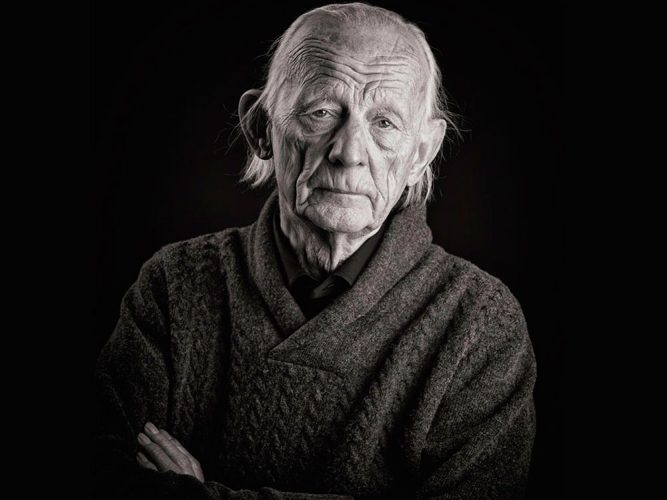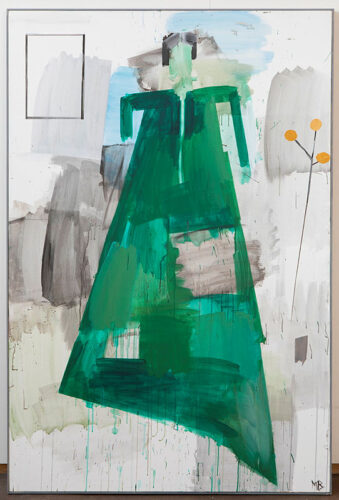The Manor House from 1665 between fjord, glacier, mountains and waterfalls
Festival art exhibitions
Brief about the two exhibitions at the Rosendal Festival 2024:
Paintings, collages, and woodcuts by Marianne Bratteli in the Wine Cellar and Borgstovo at the Castle
Digital exhibition in The Great Hall by Håkon Bleken’s Korsvei (1975–76).
Marianne Bratteli (1951– )
Bratteli grew up in a political home – her father, Trygve Bratteli (1910–1983) – was one of the leading ministers after the war and later became prime minister. He was involved in building up Norway’s post-war welfare state. During the war, he was held in German captivity and was near death when the war ended in 1945. This dark shadow from the war marked the home Marianne Bratteli grew up in. She knew something terrible had happened, but no one talked about it – until her father wrote about it in 1980.
Her art is characterized by this. For childhood plays a significant role in her images, a childhood that materially speaking was bright but at the same time thus marked by shadows from a war that had ended long before she herself was born. She started as an abstract painter, but it set limits for her need to express herself. This meant that she also began working figuratively early on. In this way, her art vibrates between abstract images showing a fine sensitivity for colors and shapes and an expressive-naïve style with motifs from both childhood and social space surrounding us. In these latter ones, she often places angular figures in the foreground – figures of women from princesses to commoners, and adult men with hats and canes reminiscent of father figures. In collages on the other hand, she often addresses existential problems that are not so easily expressed through paintings and graphics. The woodcuts are simpler both formally and iconographically but still revolve around the same themes.
Marianne Bratteli has had several major exhibitions during her career; last at Munch Museum in 2023. Her exhibitions have received very good reviews—naturally because she is among our foremost artists.
Digital exhibition in Riddarsalen by Håkon Bleken’s Korsvei from 1975–76
Håkon Bleken was commissioned by Gerhard Schwenzer, Catholic bishop of Trondheim, to create a Stations of the Cross for St. Olav’s Catholic Church in the city. The bishop specifically wanted Bleken to paint these 14 images of Jesus’ journey on Good Friday from Jerusalem to Golgotha – the Via Dolorosa – in a specific technique. The bishop was thinking of the collage technique with pasted media images because Schwenzer had previously seen some of these collages by Bleken.
To avoid the correspondence being too striking, Bleken had some assistants paste images – mostly from contemporary newspapers – onto the canvases. These include photos from the Vietnam War, Franco’s and Pinochet’s terror regimes, street battles and demonstrations, executions, executioners and their victims, as well as a few images from the Holocaust.
On top of these media images, Bleken painted the 14 stations of the cross from Jesus being condemned to death in Jerusalem to his burial, although Bleken also added a fifteenth image – the resurrection of Jesus.
The stations are: Jesus is condemned by Pontius Pilate – he receives the cross – Jesus falls for the first time – meets his mother – Simon of Cyrene helps him carry the cross – Veronica wipes the sweat from his face – he falls for the second time – speaks to the daughters of Jerusalem – falls for the third time – is stripped – nailed to the cross – dies on the cross – is taken down from the cross – and is buried.
Bleken paints with glaze colors that make the media images in the background more or less clear. Not all scenes are equally clear, but they can still be easily interpreted in the context they are in. The Stations of the Cross are primarily meditation images, which hang in all Catholic churches around the world. They are used primarily every Friday during Lent, where one moves from image to image and immerses oneself in Jesus’ painful journey towards a gruesome death. What Bleken does in these images is to shift the perspective from Jesus’ suffering to the relationship between His suffering and the world’s continuous atrocities. This is how the images become question marks that every Christian must consider. In Franz Liszt’s late work Via Crucis, we get his version of Jesus’ Way of the Cross, which can be illustrated with Bleken’s images. That is why they hang here – in addition, Bleken’s Way of the Cross also fits well with Johann Sebastian Bach’s St. John Passion.
Gunnar Danbolt

Håkon Bleken
